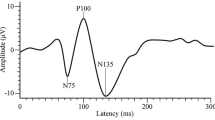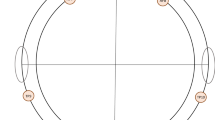Abstract
The visual system plays a prominent role in migraine headache, especially migraine with aura. Anatomical and functional studies in migraine are showing an increasing role linking the visual system to migraine and its multiple and complex clinical expressions. Recent research on photophobia highlights the progress of our understanding of these relationships. This review overviews a practicing neurologist’s view of some of the roles of the visual system in migraine and how a clinical understanding of this relationship is enhanced by recent research and discovery in this in this important area.
Similar content being viewed by others
References
Headache Classification Subcommittee of the International Headache Society (2004) The International Classification of Headache Disorders, 2nd edn. Cephalalgia 24(Suppl 1):1–160
Noseda R, Kainz V et al (2010) A neural mechanism for exacerbation of headache by light. Nat Neurosci 13(2):239–245
Leao A (1944) Spreading depression of activity in cerebral cortex. J Neurophysiol 7:379–390
Friedman DI (2004) The eye and headache. Ophthalmol Clin N Am 17:357–369
Maxner CE, Moeller JJ (2005) Visual disturbances and migraine. Curr Neurol Neurosci Rep 5(5):376–381
Queiroz LP, Rapoport AM, Weeks RE et al (1997) Characteristics of migraine visual aura. Headache 37:137–141
Russell M, Olesen J (1996) A nosographic analysis of migraine aura in a general population. Brain 119:355–361
International Headache Society Classification Committee (1988) Classification and diagnostic criteria for headache disorders, cranial neuralgias and facial pain. Cephalalgia 8(Suppl 7):1–96
Kelman L (2004) The aura: a Tertiary Care Study of 952 migraine patients. Cephalalgia 24:728
Vincent MB, Hadjikhani N (2007) Migraine aura and related phenomena: beyond scotomata and scintillations. Cephalalgia 27:1368–1377 London. ISSN0333-1024
Schott GD (2007) Exploring the visual hallucinations of migraine aura: the tacit contribution of illustration. Brain 130:1690–1703
Fisher CM (1980) Late-life accompaniments as a cause of unexplained transient ischemic attacks. J Can Sci Neurol 7:9–17
Purdy RA (2010) Late-life migrainous accompaniments. In: Gilman S (ed) Medlink Neurology. MedLink Corporation, San Diego. http://www.medlink.com
Burger SK, Saul RF, Selhorst JB, Thurston SE (1991) Transient monocular blindness caused by vasospasm. N Engl J Med 325:870–873
Grosberg BM, Solomon S, Friedman DI, Lipton RB (2006) Retinal migraine reappraised. Cephalalgia 26:1275–1286 (London. ISSN 0333-1024)
Carlow TJ (2002) Oculomotor ophthalmoplegic migraine: is it really migraine? J Neuro ophthalmol 22:215–221
Lance JW, Zagami AS (2001) Ophthalmoplegic migraine: a recurrent demylelinating neuropathy? Cephalalgia 23:84–89
Friedman DI (2010) The ophthalmoplegic migraines: a proposed classification. Cephalalgia 30(6):646–647
Lane R, Davies P (2010) Ophthalmoplegic migraine: the case for reclassification. Cephalalgia 30(6):655–661
Lafrenière RG, Cader MZ et al (2010) A dominant-negative mutation in the TRESK potassium channel is linked to familial migraine with aura. Nat Med 16(10):1157–1160
Khalil NM, Nicotra A, Wilkins AJ (2011) Asymmetry of visual function in migraine with aura: correlation with lateralization of headache and aura. Cephalalgia 31:213
Denuelle M, Fabre N, Payoux P et al (2008) Posterior cerebral hypoperfusion in migraine without aura. Cephalalgia 28:856–862
Ayata C (2009) Spreading depression: from serendipity to targeted therapy in migraine prophylaxis. Cephalalgia 29:1097–1114
Charles A, Brennan KC (2009) Cortical spreading depression—new insights and persistent questions. Cephalalgia 29:1115–1124
Lepore FE (2009) Effects of visual pathway lesions on the visual aura of migraine. Cephalalgia 29:430–435
Lashley K (1941) Patterns of cerebral integration indicated by scotomas of migraine. Arch Neurol Psychiatr 46:331–339
Hadjikhani N, Sanchez Del Rio M, Wu O et al (2001) Mechanisms of migraine aura revealed by functional MRI in human visual cortex. Proc Natl Acad Sci USA 98:4687–4692
Young W, Oshinsky M, Shechter A et al (2004) Consecutive transcranial magnetic stimulation: phosphene thresholds in migraineurs and controls. Headache 44:131–135
Tfelt-Hansen PC (2010) History of migraine with aura and cortical spreading depression from 1941 and onwards. Cephalalgia 30(7):780–792
Weiller C, May A, Limroth V, Jupter M, Kaube H, Schayck RV et al (1995) Brain stem activation in spontaneous human migraine attacks. Nat Med 1:658–660
Shams PN, Plant GT (2011) Migraine-like visual aura due to focal cerebral lesions: case series and review. Surv Ophthalmol 56:135–161
Acknowledgments
Thanks to two colleagues and neurophthalmogists, Dr. Debrorah I. Friedman and Dr. Charles E. Maxner for their helpful assistance in directing me to some of the pertinent literature on this complex subject.
Conflict of interest
The author declares that there is no actual or potential conflict of interest in relation to this article.
Author information
Authors and Affiliations
Corresponding author
Rights and permissions
About this article
Cite this article
Purdy, R.A. The role of the visual system in migraine: an update. Neurol Sci 32 (Suppl 1), 89–93 (2011). https://doi.org/10.1007/s10072-011-0541-4
Published:
Issue Date:
DOI: https://doi.org/10.1007/s10072-011-0541-4




